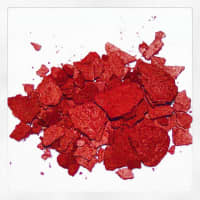Lycopene is a bright red carotenoid hydrocarbon found in tomatoes and other red fruits and vegetables, such as red carrots, watermelons, grapefruits, and papayas, but it is not present in strawberries or cherries. Foods that are not red may also contain lycopene, such as asparagus and parsley.[1]
Composition
Lycopene is a tetraterpene.
Lycopene has no vitamin A activity.
It is insoluble in water.
Healing Properties
Antiinflammatory (anti-inflammatory)
Nanolycopene showed anti-inflammatory effects.[2]
Antioxidant
Lycopene is an exogenous antioxidant (exogenous antioxidants are antioxidants we get from our diet by eating antioxidant-rich foods and by taking supplements).[1:1]
Blood Healhy
Liver Health
Nanolycopene showed liver reservoir and recirculation properties.[2:1]
Skin Health
Photoprotective
UV light exposure has been shown to decrease skin lycopene concentrations. Therefore lycopene supplementation before UV-Light exposure may be beneficial.[1:2]
Lycopene protects against UV-induced erythema in humans.[1:3]
- Erythema is a superficial reddening of the skin, usually in patches, as a result of injury or irritation causing dilatation of the blood capillaries.[1:4]
Disease / Symptom Treatment
Rheumatoid Arthritis
Nanolycopene showed anti-inflammatory effect in Rheumatoid Arthritis.[2:2]
Sunburn
Lycopene protects against UV-induced erythema in humans.[1:5]
Study Type: Preprint: Review Paper
Title: An extensive Review of Sunscreen and Suntan Preparations
Author(s): AK Mohiuddin
Institution(s): Department of Pharmacy, World University of Bangladesh; 151/8, Green Road, Dhanmondi, Dhaka –1205, Bangladesh
Publication: Preprint
Date: April 2019
Abstract: The sunscreen industry is achieving remarkable worldwide prominence by responding to the growing need for skin protection with fast-paced innovation. Increased consumer awareness of the harmful effects of sunlight has fueled the demand for improved photo protection. The need for broad-spectrum protection from both UVA and UVB rays has inspired scientists worldwide to research new cosmetic formulations and delivery systems. More effective sunscreen actives, emollients and novel cosmetic and functional ingredients have been regularly added to the formulator’s repertoire. Creativity in innovation has been hindered only by regulatory agencies and patent restrictions worldwide. Familiarity with the current restrictive regulations and patent law infringements has become integral to any research effort attempting to provide improved protection to individuals affected by the sun’s damaging effects. The increasing incidence of skin cancers and photo damaging effects caused by ultraviolet radiation has increased the use of sun screening agents, which have shown beneficial effects in reducing the symptoms and reoccurrence of these problems. Unlike the situation in Europe where sunscreen ingredients are considered under cosmetics guidelines, the FDA is required to define sunscreens as drugs since they are advertised to prevent sunburn and, more recently, the risk of skin cancer. In the USA, the FDA has been regulating this industry since August 25, 1978, with the publication of the Advance Notice of Proposed Rulemaking. Sunscreens are considered drugs and cosmetics and therefore must be governed by the FDA-OTC monograph. With the variety of sunscreen agents used in cosmetic and UV protection products, Australia, Canada, and the European Union (EU) have also developed regulatory protocols on safe sunscreen product use. Unlike the USA though, Australia has approved 34 active sunscreen ingredients and the EU has approved 28 of these ingredients. Current FDA regulations allow labeling of sunscreen products to a maximum of 30þ, despite the many products currently available with numbers as high as 100. From a cosmetic formulation point of view, increasing the SPF number in a product is governed by simple chemical principles.
Link: Source
Citations: ↩︎ ↩︎ ↩︎ ↩︎ ↩︎ ↩︎Study Type: Animal Study: In Vivo
Title: Lycopene used as Anti-Inflammatory Nanodrug for the Treatment of Arthritis Rheumatoid: Animal assay, Pharmacokinetics, ABC Transport and Tissue Deposition
Author(s): Vivian Moia, Filipe Leal Portilho, Edward Helal-Neto, Tatiana Almeida Pádua, Luana Barbosa Corrêa, Eduardo Ricci-Junior, Elaine Cruz Rosas, Luiciana Magalhaes Rebelo Alencar, Francisco Savio Mendes Sinfronio, Angelina Sampson, Surtaj Hussain Iram, Frank Alexis, Maria dasGraccedilas Muller de OliveiraHenriques, Ralph Santos-Oliveira
Institution(s): Brazilian Nuclear Energy Commission, Nuclear Engineering Institute, Rio de Janeiro, Brazil; Laboratory of Applied Pharmacology, Farmanguinhos, Oswaldo Cruz Foundation, Rio de Janeiro, Brazil; Federal University of Rio de Janeiro, College of Pharmacy, Galenical Development Laboratory, Rio de Janeiro, Brazil; Federal University of Maranhão, Department of Physics, Maranhão, Brazil; Federal University of Maranhão, Department of Electrical Engineering, Maranhão, Brazil; Department of Chemistry and Biochemistry, College of Natural Sciences, South Dakota State University, Brookings, South Dakota; School of Biological Sciences and Engineering, Yachay Tech, San Miguel de Urcuquí, Ecuador; Zona Oeste State University, Laboratory of radiopharmacy and Nanoradiopharmaceuticals, Rio de Janeiro, Brazil
Publication: Colloids and Surfaces B: Biointerfaces
Date: January 2020
Abstract: Lycopene is a carotenoid drug that has demonstrated several properties, including antioxidant and anti-inflammatory activity. The absorption in human body is very low (10-30% only). In order to increase the bioavailability, lycopene nanoemulsion was formulated and characterized (atomic force microscopy, thermogravimetric analysis dynamic light scattering and differential scanning calorimetry). Also in vitro assay to evaluate the at-binding with MPR1 was performed. Finally, in vivo assay in animals inducted with rheumathoid arthritis were performed. The results showed that the formulated nanolycopene had superior efficacy when compared with the conventional lycopene (not nano-formulated) in inducted animals (rheumatoid arthritis). The results support the use of nanolycopene as an anti-inflammatory agent for rheumatoid arthritis therapy.
Link: Source
Citations: ↩︎ ↩︎ ↩︎
